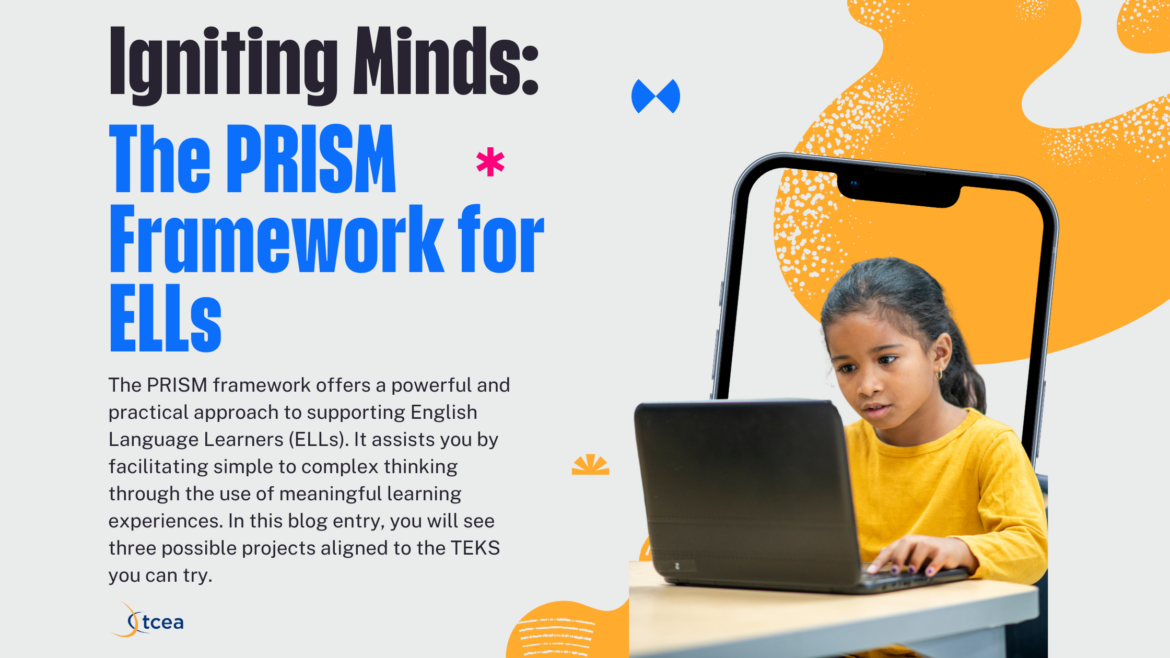The PRISM framework offers a powerful and practical approach to supporting English Language Learners (ELLs). It assists you by facilitating simple to complex thinking through the use of meaningful learning experiences. In this blog entry, you will see three possible projects aligned to the TEKS that will help you incorporate the PRISM Framework for ELLs.
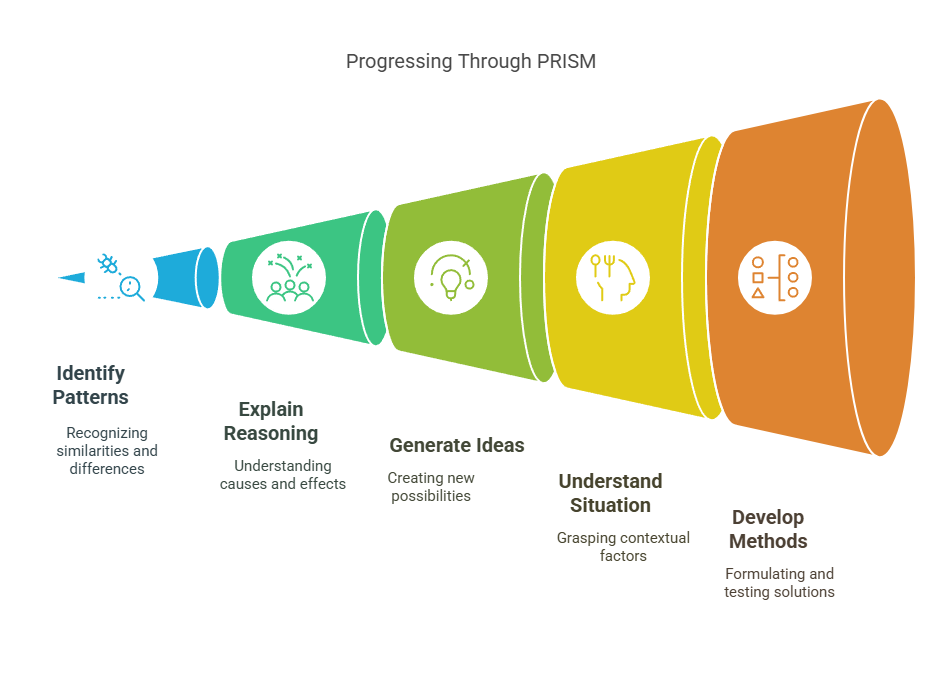
These experiences match the acronym, which stands for Patterns, Reasoning, Ideas, Situation, and Methods:
- Patterns: Identifying similarities and differences.
- Reasoning: Explaining why things happen.
- Ideas: Generating new ideas and possibilities.
- Situation: Understanding the context of a problem.
- Methods: Developing and testing solutions.
Combine PRISM with project-based learning to get benefits of:
- Creativity
- Critical thinking
- Language development
Let’s explore these ideas via three example projects for grades K-2, 3-6, and 6-8. Before we do that, let’s get a big picture of each project.
PRISM in Action: Grade-Specific Ideas
First, let’s take a look at this organizer showing projects and each step of the PRISM Framework for ELLs. Notice how PRISM scaffolds students as they move from simple to complex.
- Patterns: Students identify recurring features in their neighborhood (K-2), cultural symbols (3-5), and sustainable features (6-8), focusing on related vocabulary.
- Reasoning: Students explain the purpose of neighborhood features (K-2), the significance of cultural symbols (3-5), and the benefits of sustainable features (6-8), practicing explanatory language.
- Ideas: Students brainstorm improvements for their neighborhood (K-2), compare cultural traditions (3-5), and propose sustainability solutions (6-8), developing creative and comparative language.
- Situation: Students discuss community cooperation (K-2), global traditions (3-5), and the global impact of local actions (6-8), focusing on social interaction and global awareness vocabulary.
- Methods: Students practice conversational English through role-play (K-2), collaborate on presentations (3-5), and present their solutions with Q&A (6-8), enhancing spoken English and presentation skills.
With that big picture overview, let’s go a bit deeper into each project.
Project Spotlight: Engaging ELLs Across Grade Levels
Let’s take a closer look at each project idea and how the PRISM framework and TEKS alignment come together in practice. Each comes with an AI-aided TEKS alignment. Be sure to check to see if it applies to your own classroom and curriculum goals.
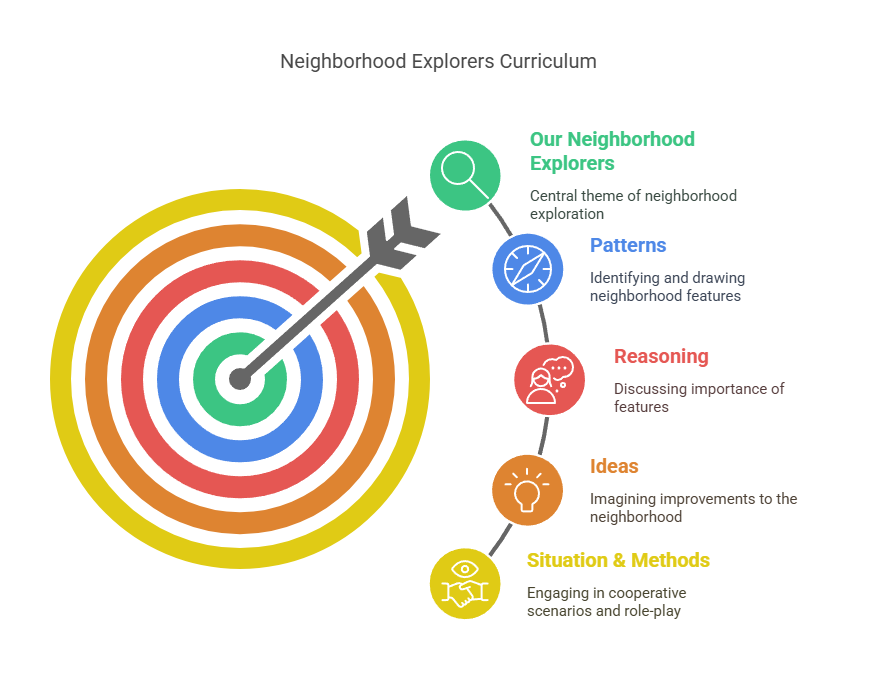
Neighborhood Storybooks: A K-2 Adventure in Community Exploration
Young learners connect best with what they know. K-2 ELLs create storybooks about their neighborhoods to learn vocabulary, storytelling, and community.
PRISM Breakdown
Patterns: Students identify and draw recurring elements in their neighborhoods (e.g., houses, trees, stores).
- TEKS Alignment: Mathematics §111.11.b.1.C – identify, create, and extend patterns of objects, pictures, and numbers.
- Other TEKS: Visual Arts §117.103(b)(1)(A) – identify the elements of art, including line, shape, color, texture, and space, in their own artwork.
Reasoning: They use sentence stems (e.g., “My house has a _____”, “The park is for _____”) to discuss the purpose of these places.
- TEKS Alignment: ELAR §110.4(b)(7) – express complete thoughts and ideas clearly.
- Other TEKS: ELAR §110.4(b)(8) – share information and ideas that are relevant to the topic or text.
Ideas: Students imagine and draw new things they would like to see in their neighborhood (e.g., a playground, a library).
- TEKS Alignment: ELAR §110.5(b)(4) – generate ideas before writing or speaking.
Situation: The class discusses how neighbors help each other and participate in community events.
- TEKS Alignment: Social Studies §113.12(b)(1)(A) – identify the responsibilities of citizens.
Methods: Students role-play simple conversations related to their neighborhood (e.g., asking for directions, greeting a neighbor).
- TEKS Alignment: ELAR §110.4(b)(5) – participate collaboratively in conversations with peers and adults in small and larger groups.
- Other TEKS: ELAR §110.4(b)(6) – speak audibly and clearly using appropriate language for the situation.
- ELPS Alignment: This activity strongly aligns with various aspects of the English Language Proficiency Standards (ELPS), particularly regarding speaking and listening skills in social and academic contexts. You could specifically reference the ELPS expectations for the students’ grade level related to expressing themselves and interacting with others.
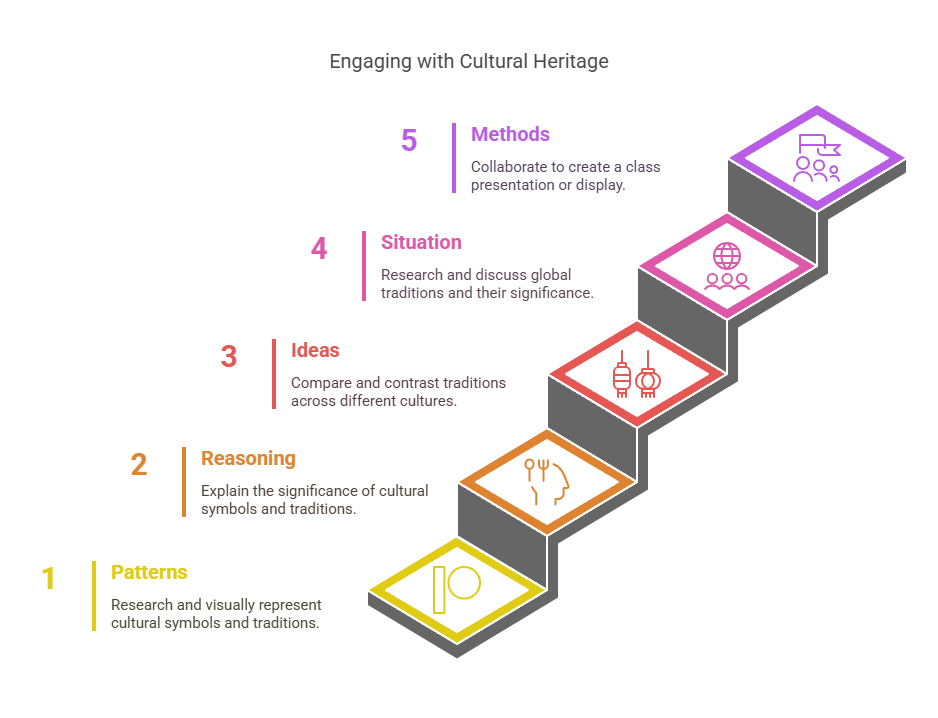
Cultural Quilts: Weaving Heritage into 3-5 Learning
For grades 3-5, the “Cultural Heritage Celebrations” project celebrates the diverse backgrounds of students. The “Cultural Heritage Celebrations” project for grades 3-5 allows students to design quilt squares representing their cultural heritage, celebrating diversity and building descriptive language skills.
PRISM Breakdown
Patterns: Students draw or represent cultural symbols, traditions, or celebrations that are important to them or their families.
- TEKS Alignment: Visual Arts §117.106(b)(1)(A) – identify and describe cultural contexts expressed in art.
- Other TEKS: Social Studies §113.15(b)(1)(B) – identify and describe customs, traditions, and celebrations of various cultural groups in the community and other parts of the world.
Reasoning: Learners explain the significance and meaning behind their chosen symbols or traditions.
- TEKS Alignment: Social Studies §113.15(b)(2)(B) – explain the significance of various cultural celebrations.
Ideas: Facilitate classroom discussions where students compare and contrast different cultural traditions represented in their quilt squares.
- TEKS Alignment: ELAR §110.9(b)(4) – compare and contrast information in texts and graphics.
- Other TEKS: Social Studies §113.15(b)(2)(A) – compare and contrast customs, traditions, and celebrations of different cultural groups.
Situation: Students research global traditions and celebrations, exploring their origins and significance in different parts of the world.
- TEKS Alignment: Social Studies §113.17(b)(1)(A) – identify customs and celebrations of various cultural groups.
Methods: The class collaboratively assembles the individual quilt squares into a class quilt, creating a visual representation of their diverse heritage.
- TEKS Alignment: Social Studies §113.18(b)(1)(B) – work independently and collaboratively.
Enhancing the Project for ELLs:
- Provide examples of cultural symbols and traditions from various cultures.
- Encourage students to interview family members about their heritage.
- Use bilingual resources and allow students to use their native language for initial brainstorming and note-taking.
- Provide sentence starters for explaining the significance of their symbols.
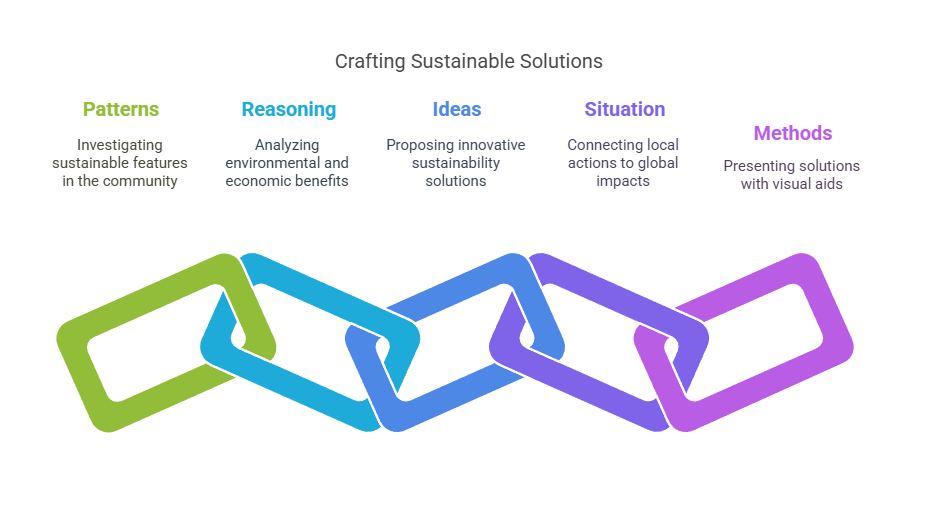
Eco-School Design: 6-8 Sustainability Showcase
Middle school ELLs engage in problem-solving and critical thinking with the “Sustainable Solutions Challenge” project. This activity combines research, design, and presentation skills. Students work to propose eco-friendly solutions for their school or community.
PRISM Breakdown
Patterns: Students research common features of sustainable buildings and practices (e.g., solar panels, rainwater harvesting, recycling programs).
- TEKS Alignment: Science §112.18(b)(2)(A) – identify and describe the properties of natural resources.
Reasoning: Learners explain the environmental and economic benefits of these sustainable features using cause-and-effect language.
- TEKS Alignment: Science §112.19(b)(1)(B) – analyze data to formulate reasonable explanations.
Ideas: Encourage students to brainstorm innovative and practical sustainability solutions tailored to their school or community’s needs.
- TEKS Alignment:
- Grade 6-7: ELAR TEKS 110.5(b)(4) – plan a first draft by generating ideas.
- Grade 8: ELAR TEKS 110.6(b)(1)(A) – generate and organize ideas for composing clear, innovative responses.
Situation: Students connect their proposed solutions to broader global environmental challenges, understanding the importance of sustainability on a larger scale.
- TEKS Alignment: Science §112.20(b)(1)(D) – evaluate the impact of human activities on Earth systems.
Methods: Students present their designs and solutions to the class, incorporating visual aids and participating in a Q\&A session to receive peer feedback.
- TEKS Alignment: Technology Applications §126.16(b)(1)(A) – present information in a variety of formats.
To better enhance the project for English Language Learners, consider taking advantage of the SAVE process.
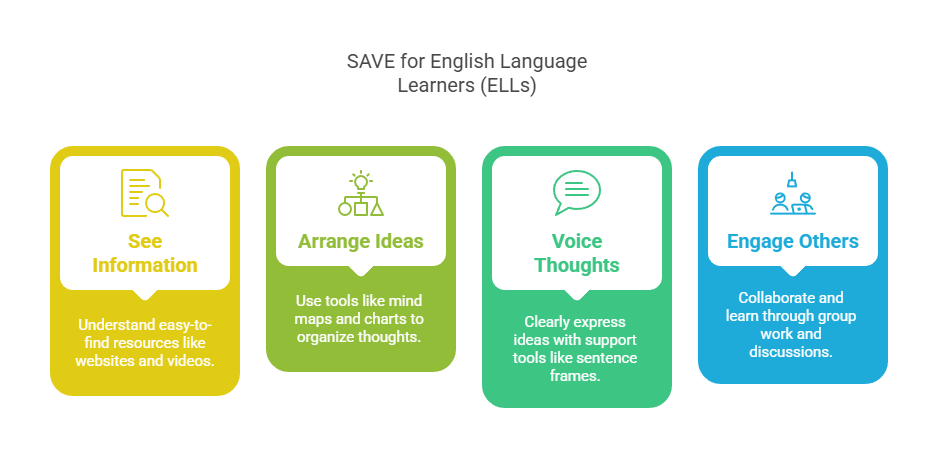
SAVE Earth: Steps and Resources
It can be easy to forget second language learners need a bit more scaffolding. The SAVE process can assist language learners in these ways: offer visual and simplified information, provide tools to organize thoughts without relying on words alone, as well as give sentence support to clearly express their ideas.
SAVE Earth: Steps and Resources
S: See and understand easy-to-find information (e.g., websites, videos, diagrams)
- Example: Watch a short video explaining the concept of the carbon footprint.
- Resources:
- Website: NASA Climate Kids – Provides engaging articles, games, and videos about climate change.
- Video: “What is Climate Change?” by National Geographic Kids on YouTube
- Diagram: Search online for “water cycle diagram for kids” or “food web diagram simple”.
A: Arrange your ideas using helpful tools (e.g., mind maps, charts)
- Example: Create a mind map to brainstorm different ways to reduce plastic waste.
- Resources:
- Use a free online mind mapping tool like MindMeister or draw one on paper.
- Create a chart comparing the energy consumption of different appliances (search online for energy consumption charts).
- Develop a flowchart outlining the steps of recycling (search online for recycling process flowcharts).
V: Voice your thoughts clearly with support (e.g., sentence frames, prompts)
- Example: Use the sentence frame: “One way to help the environment is by __ because __.”
- Resources:
- Sentence Frames:
- “The impact of pollution is __ because __.”
- “A sustainable solution to this problem could be __.”
- “I think this is important because __.”
- Prompts:
- “Explain the difference between renewable and non-renewable energy.”
- “Describe one way your school could become more environmentally friendly.”
- Sentence Frames:
E: Engage with others and learn together (e.g., group work, discussions)
- Example: Participate in a group discussion about the pros and cons of different energy sources.
- Resources:
- Group Work Activity: Plan a school-wide recycling campaign as a team.
- Discussion Prompts:
- “What are some of the biggest environmental challenges facing our community?”
- “How can young people make a difference in protecting the environment?”
- Peer Feedback: Share your ideas for reducing waste with a partner and get their suggestions.
Project-Based Learning and PRISM Framework for ELLs
PRISM and TEKS with SAVE create engaging, hands-on learning for ELLs, boosting language skills, critical thinking, and collaboration. These projects empower their academic and linguistic success in Texas classrooms.
Let us know how you plan to use the PRISM Framework for ELLs in the comments below!

